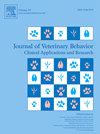Survey on the importance of different traits for medical detection dogs
IF 1.3
3区 农林科学
Q4 BEHAVIORAL SCIENCES
Journal of Veterinary Behavior-clinical Applications and Research
Pub Date : 2024-11-01
DOI:10.1016/j.jveb.2024.08.004
引用次数: 0
Abstract
Medical detection dogs are used to remotely detect a range of diseases (biodetection) and assist patients with chronic conditions. There has been little research on the behavioral traits linked to performance for these roles. We developed a survey to investigate which attributes are most important in medical detection dogs and how these vary between dogs used for bio-detection and medical alert assistance. The survey was completed by 62 professionals working in 16 different countries. The most important traits were “Level of motivation when working”, “Health”, “Ability to learn from being rewarded, “Concentration”, and “Acuity of sense of smell”. Trait importance differed significantly between the roles: “Level of Attachment to human partner, “Confidence in different environments” and “Travel ability” were deemed significantly more important for assistance dogs. “Acuity of sense of smell”, “Tendency to be distracted when working”, and “Ability to solve problems when working” were more important for biodetection dogs. Ideal levels also differed between the roles, for example, biodetection dogs were thought to require higher levels of “Tendency to search by smell alone” but lower levels of “Attachment to human partner” than assistance dogs. When comparing ratings for the current dogs to the perceived ideal levels, there were significant deviations in several traits; e.g. dogs were generally rated as having higher than desired levels of “General excitability” and “Tendency to be distracted when working”. Paying particular attention to important traits and those that differ greatly from ideal levels when selecting medical detection dogs may aid future task success.
关于医疗检测犬不同特征重要性的调查
医疗检测犬用于远程检测一系列疾病(生物检测),并为慢性病患者提供帮助。目前对与这两种角色的良好表现相关的行为特征的研究还很少。我们进行了一项调查,以了解医疗检测犬的哪些行为特征最为重要,并研究这些特征在用于生物检测和医疗警报辅助任务的犬之间有何不同。来自 16 个不同国家的 62 名与医疗检测犬打交道的专业人员完成了这项调查。参与者对每项评分考虑了 40 个特征:选择过程中的重要性、所需的理想水平以及最近与之合作过的犬所表现出的水平。总体而言,39 位受访者对辅助犬进行了评级,23 位对生物检测犬进行了评级。最重要的特征是 "工作时的积极性"(1-5 级平均值 = 4.66 ± 0.51)、"健康"(4.60 ± 0.62)、"从奖励中学习的能力"(4.57 ± 0.57)、"专注力"(4.57 ± 0.60)和 "敏锐的嗅觉"(4.5 ± 0.76)。三种角色的特质重要性差异很大:"对人类伙伴的依恋程度"(U = 685,= 0.001)、"在不同环境中的信心"(U = 604,= 0.002)和 "旅行能力"(U = 576,= 0.018)被认为对辅助犬更为重要。"嗅觉敏锐度"(U = 280,= 0.004)、"工作时容易分心"(U = 279.5 = 0.009)和 "工作时解决问题的能力"(U = 310 = 0.009)对生物探测犬更为重要。不同角色的理想水平也不尽相同,例如,生物探测犬对 "仅靠嗅觉搜索的倾向"(U = 277.5 = 0.006)的要求较高,但对 "对人类伙伴的依恋"(U = 277.5 < 0.001)的要求则低于辅助犬。如果将目前狗狗的评分与理想水平进行比较,会发现一些特征存在显著偏差;例如,狗狗的 "一般兴奋性"(平均偏差 = 1.02)和 "工作时容易分心"(平均偏差 = 1.00)普遍高于理想水平。在选择医疗检测犬时,特别注意那些重要的特征以及那些与理想水平相差较大的特征,可能有助于提高任务的成功率。如果要优化后续表现,就必须在选择时考虑医疗检测犬任务之间的差异。
本文章由计算机程序翻译,如有差异,请以英文原文为准。
求助全文
约1分钟内获得全文
求助全文
来源期刊
CiteScore
3.50
自引率
16.70%
发文量
107
审稿时长
325 days
期刊介绍:
Journal of Veterinary Behavior: Clinical Applications and Research is an international journal that focuses on all aspects of veterinary behavioral medicine, with a particular emphasis on clinical applications and research. Articles cover such topics as basic research involving normal signaling or social behaviors, welfare and/or housing issues, molecular or quantitative genetics, and applied behavioral issues (eg, working dogs) that may have implications for clinical interest or assessment.
JVEB is the official journal of the Australian Veterinary Behaviour Interest Group, the British Veterinary Behaviour Association, Gesellschaft fr Tierverhaltensmedizin und Therapie, the International Working Dog Breeding Association, the Pet Professional Guild, the Association Veterinaire Suisse pour la Medecine Comportementale, and The American Veterinary Society of Animal Behavior.

 求助内容:
求助内容: 应助结果提醒方式:
应助结果提醒方式:


